David Alaba has been a mainstay of Bayern Munich’s starting XI for nearly a decade but this season, he has brought his game to a different level. With die Roten suffering from injuries to Niklas Süle and Lucas Hernandez in defence and somewhat struggling under Niko Kovač, the team needed a change if they were to get back to their extremely high standards. After promoting Hansi Flick from assistant coach to the interim manager, the German turned to Alaba to help solve Bayern’s defensive woes. The Austrian international deputised as a left centre-back and has excelled not only in defence but also in the build-up phase for Bayern.
The quality in his performances has meant that Flick has played him in every minute of Bundesliga action since becoming the interim boss. It has also coincided with Bayern returning to top form and to the top spot of the league as well as becoming one of the favourites for the Champions League. This scout report will provide a tactical analysis of David Alaba’s contribution to Bayern Munich’s Bundesliga season that will showcase his defensive solidity as well as his excellence in possession and helping Bayern’s ball progression.
Defensive positioning
As a defender, it is the most important thing that Alaba consistently contributes heavily to the defensive phase. His frame (stands at 1.80m) is not common for a traditional centre-back, which means that he isn’t able to dominate in the air. This is shown by the fact he only wins 0.9 aerial duels per game, albeit with a success rate of 54% which is a decent figure.
Therefore, Alaba has to use his great positioning, game intelligence and his ability in challenges to help stabilise Bayern’s defence. Given that Bayern play a high line with at least one of their full-backs pushing forwards, it’s usually up to Alaba and his centre-back partner, Jerome Boateng, to stop the opposition from counter-attacking.
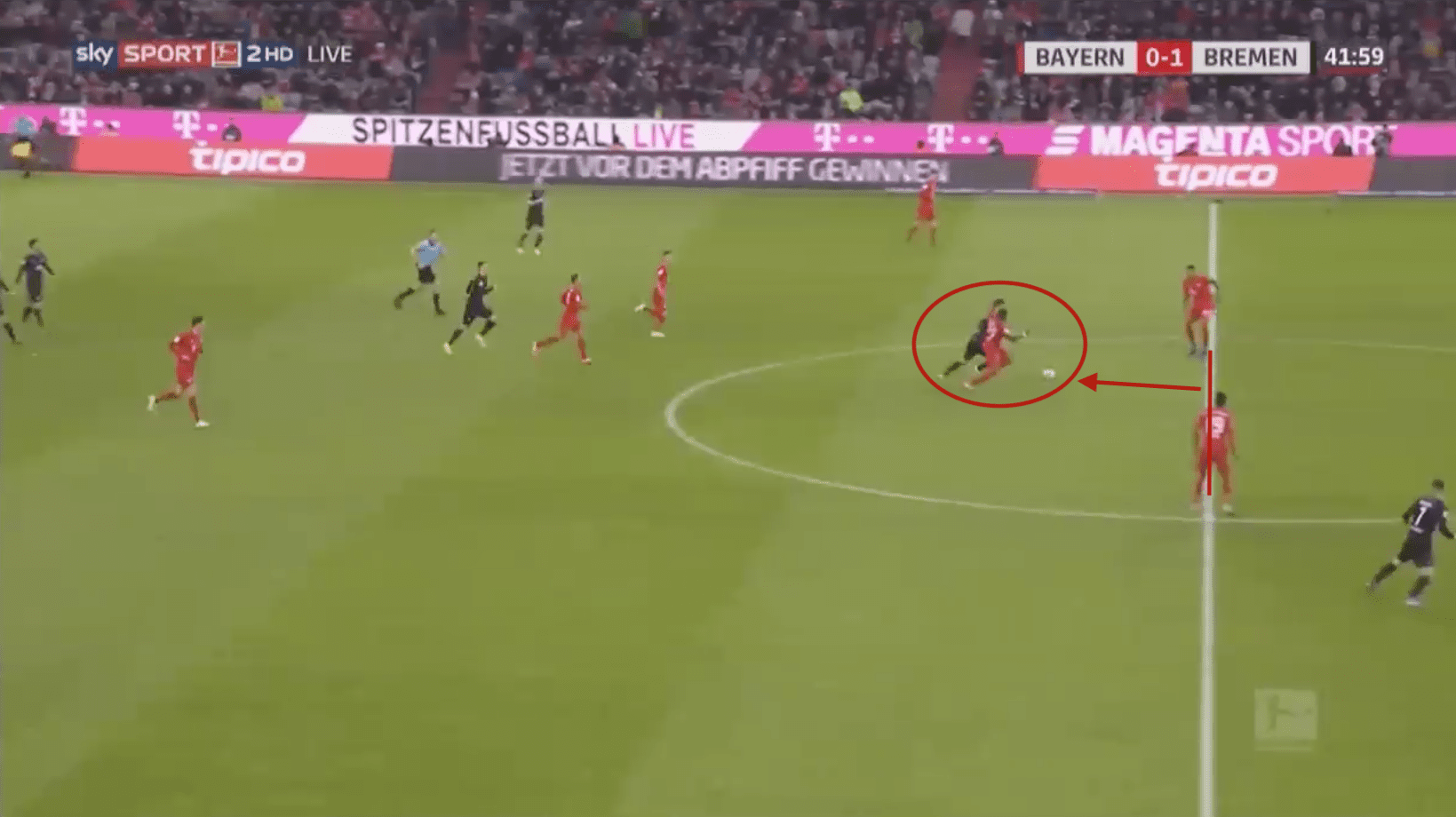
Above is a scenario that often comes into play, with Alphonso Davies helping as the defensive full-back. Alaba steps up to provide pressure on the man on the ball. Boateng and Davies are tasked with holding their shape and the defensive line has to play the offside trap and be ready to either run back if the opposition gets past or force a turnover by tackling the opponent. Usually, Boateng is tasked with providing pressure but both Alaba and Boateng are capable of playing either role. The 27-year-old is able to get tight to the Werder Bremen player and tackles the ball of him, ending a potential threat on Bayern’s goal given the huge space in behind the defence. It looks quite simple, yet the ability to work alongside another centre-back is not something that Alaba is used to. As well as that, if the challenge goes awry, it leaves Bayern even more susceptible at the back or could get Alaba in the referee’s book.
Earlier in the half, Bayern were caught out in the counter-attack as they were sending numbers forward to get an equaliser, which is shown in the image below. Milot Rashica is the Werder player in possession and his pace is hurting die Roten’s defence, which is proven by the fact he has already scored on the counter. Boateng looks to close him down with the help of Benjamin Pavard but that leaves two Werder players attacking Alaba and the space in behind him.
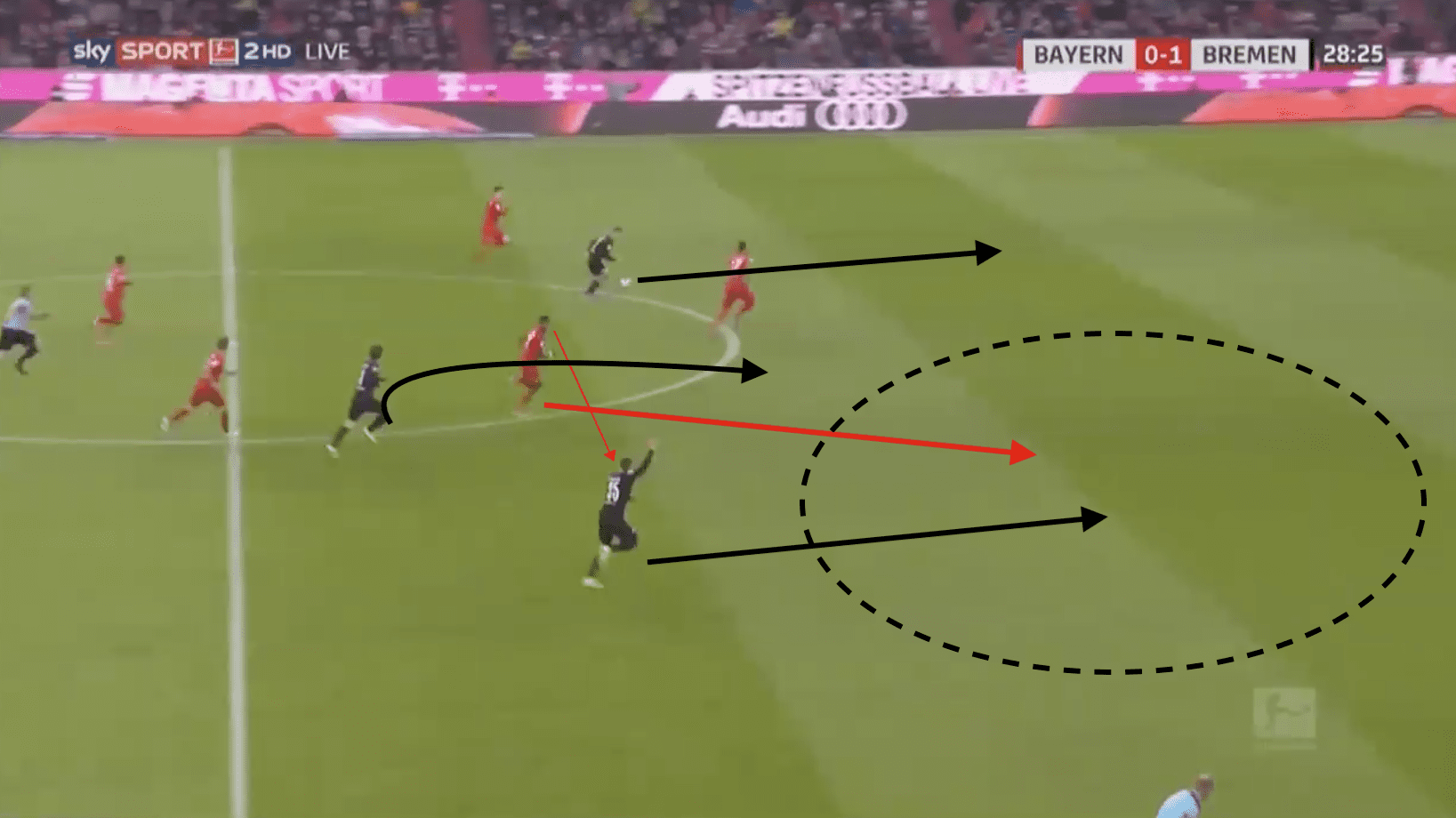
Alaba has a glance over to see where the most dangerous option is and focuses his attention on him, knowing that Joshua Kimmich is close to the other opponent. The Austrian is able to use his great speed and position himself to cut the passing option to the opponent, despite having been in a disadvantageous position.
His positioning forced Rashica to go solo and he eventually lost possession of the ball following pressure from Pavard and Boateng. Once again, it is a relatively simple action that is expected from a player of Alaba’s quality, but his sensational positional awareness is what helps give Bayern more solidity in defence.
Passing ability and playmaking
However, what makes Alaba a crucial member of the Bayern Munich starting XI is his ability to pass the ball. Bayern have had their fair share of great ball-playing defenders in the past with Alaba’s partner Boateng being one of them, and Alaba has shown signs that he has the capabilities of becoming one himself. Die Roten are blessed to have two great ball progressors in midfield in Thiago Alcantara and Joshua Kimmich thus making Alaba’s job a little easier. When passing, Alaba therefore only usually has two options: 1) play direct and vertical passes into the attacking midfielders or forwards or 2) switch the ball or find the wide players waiting on either the wide half-spaces or the wing.
Usually, Alaba plays a short pass into Thiago who can start the build-up play, but opposition players are wary of that, thus cut the passing lane to him as shown in the scenario below.
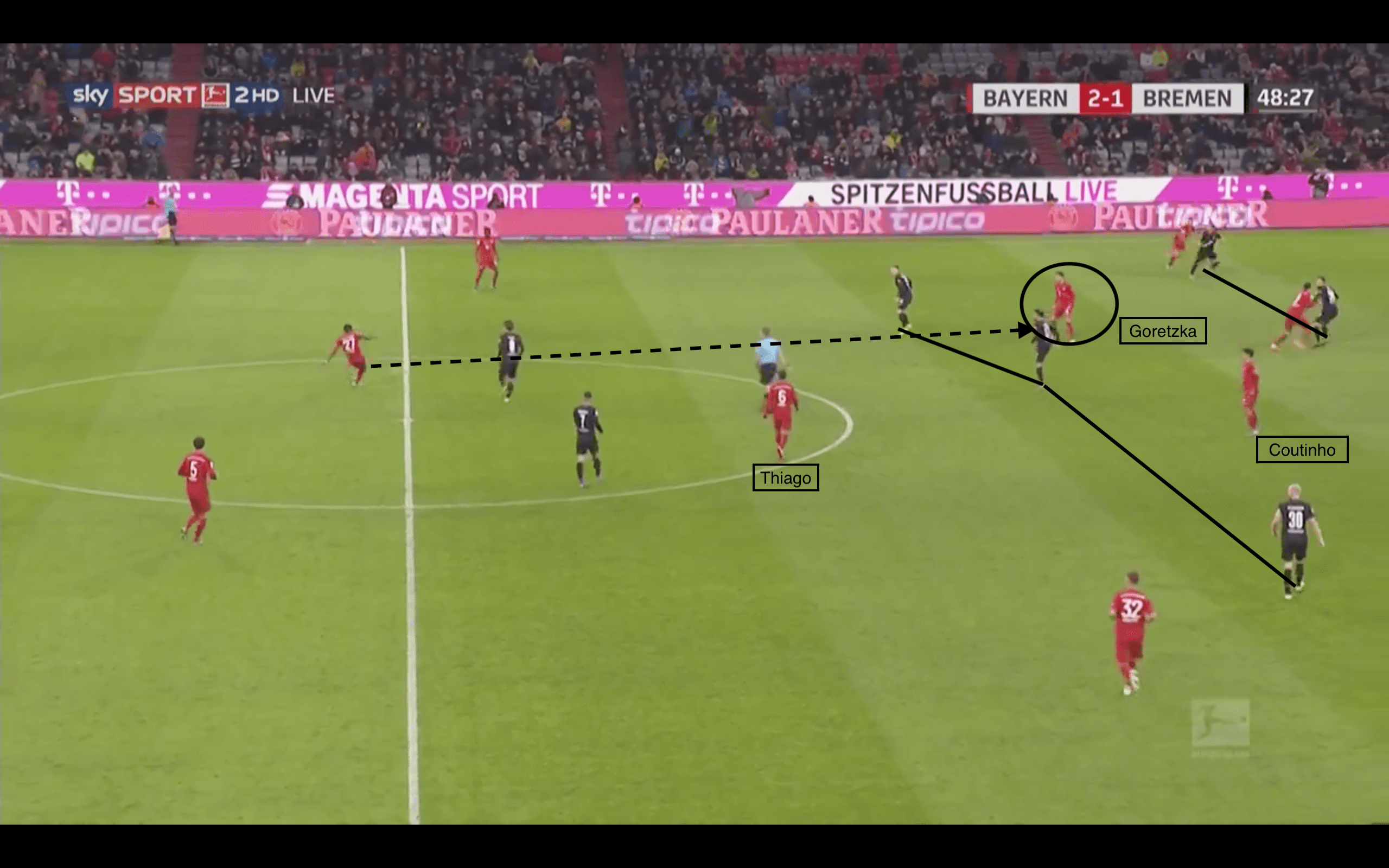
With the passing lane to Thiago is cut off, it means Alaba will have to now play a vertical pass into the middle of the pitch. Both Leon Goretzka and Phillipe Coutinho have dropped in between the lines with both players seemingly open. Alaba opens his body up and decides to play the simpler pass to Goretzka with pinpoint accuracy. Given that the two defenders in front of the German are occupied, Goretzka is able to turn and drive into the box. In this case, Werder Bremen win back the ball but the vertical passes from defence are a great asset for Bayern when the midfielders are unable to get the ball.
Just before the moment, the image below was taken, great counter-movement from Bayern is able to set up a switch for Alaba. The passing lane to Kingsley Coman was blocked off by Jadon Sancho just before Alaba received the ball. Lewandowski’s intuitive movement to drop a little deep gets the attention of the opposition centre-backs. Müller’s positioning alongside him drags Borussia Dortmund’s left-back Nico Schulz a little bit into the centre to make it more compact in the middle and reduce the space for the attackers to operate in.
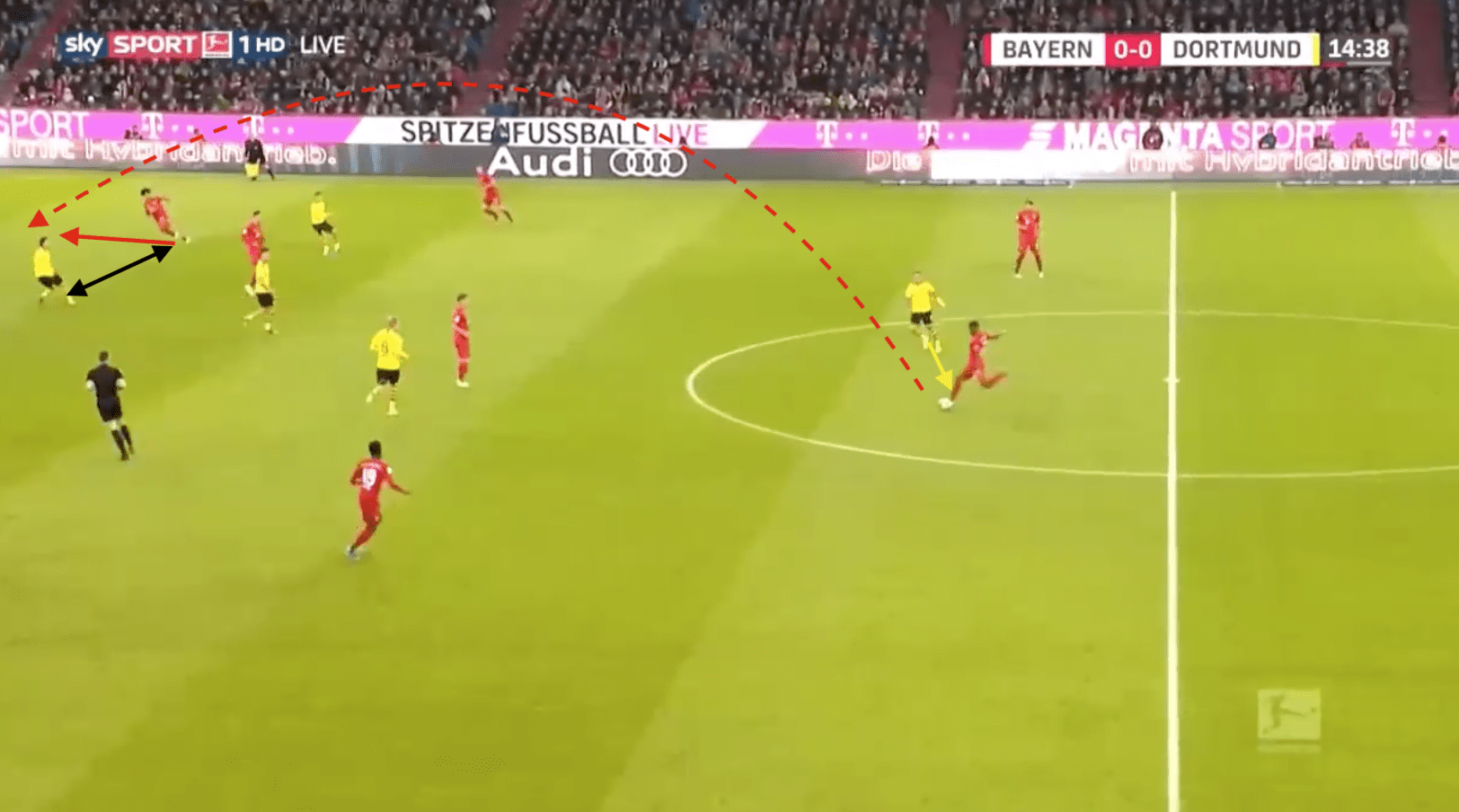
Now, we have the moment in which Alaba receives the ball. Mario Götze looks to close down Alaba, but the 27-year-old has a great touch and has enough time to pick up a pass. Serge Gnabry is hovering in the half-space and has begun making a run in behind at the same time. Alaba is able to recognise the distance between Schulz and Gnabry is just big enough for a direct pass to get to Gnabry without the German being challenged. Alaba plays a superb pass into Gnabry, but he swipes at the air when going for the volley thus wasting the opportunity.
On rare occasions, Alaba has the opportunity to play the final ball, which can be seen in the example below. With Bremen playing a higher line than usual and Bayern’s creative midfielders, it’s up to Alaba to make an attacking play.

He recognises that there is space in behind that can be exploited and makes eye contact Coutinho. This is the signal for the Brazilian to make a darting run and take advantage of Bremen’s lacklustre offside trap attempt. The Austrian finds Coutinho with a superb long pass, and the attacking playmaker finishes expertly to give Bayern a healthy lead in the game.
Covering depth
When looking at Alaba’s numbers for defensive statistics such as tackles and interceptions, they are relatively low for a centre-back as he is only averaging 2.1 tackles and interceptions per game. Of course, statistics are not as useful for defenders as they are for midfielders or attackers, but it can help paint a picture especially used with context. The reason for such low numbers is twofold: Bayern Munich are the only team in the league with an average possession per game above 60% and they are the team with the lowest PPDA in the league with a value of 7.29.
The former implies that Bayern are the best at keeping the ball so Alaba will naturally have to do less defensive work. The latter highlights that when die Roten do lose the ball, they are very aggressive in the press and are great at winning the ball quickly (only allowing just over seven passes per defensive action). This usually will happen higher up the pitch as evidenced by the fact that the attacking players have comparable tackles and interception numbers to Alaba.
The only way opponents can thus effectively beat Bayern’s press is to play a direct and counter-attacking style. This means that Alaba has to be great at covering space, which was slightly touched on earlier and goes hand in hand with his superb positional awareness.
The most common scenario for Alaba to cover depth is when Alphonso Davies pushes forward given his prowess in attack. This leaves Alaba to cover the space left behind, but since he is a left-back by trade, it is not much of an issue and given Bayern’s structure and tactics it makes it easier for him.
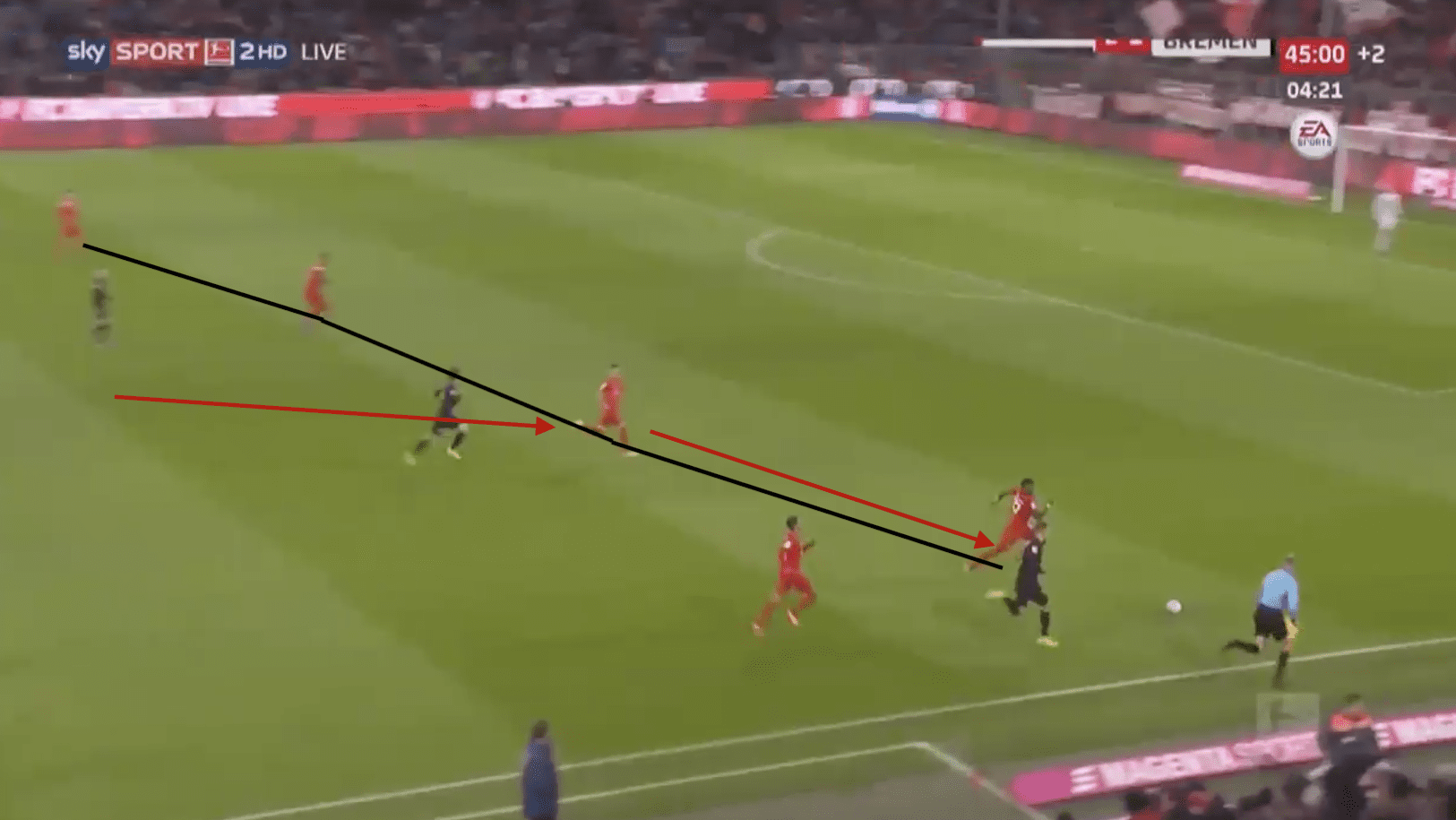
In the image above, Alaba steps across to the left-back position to close the Bremen player in possession who is driving with the ball at pace. Luckily for the Austrian, Kimmich drops from central midfield to cover the central space that Alaba left and Bayern are able to keep a solid defensive line. The 27-year-old is able to win the exchange with the opponent via a slide tackle, which goes out for a throw-in allowing Bayern to recover defensively.
The example below is quite similar, this time with Kimmich out of position as he is playing centre-back as a replacement for Boateng. Luckily for Bayern, Werder are only attacking with two players meaning that the defence is not fully stretched but it is still a tough scenario to defend.
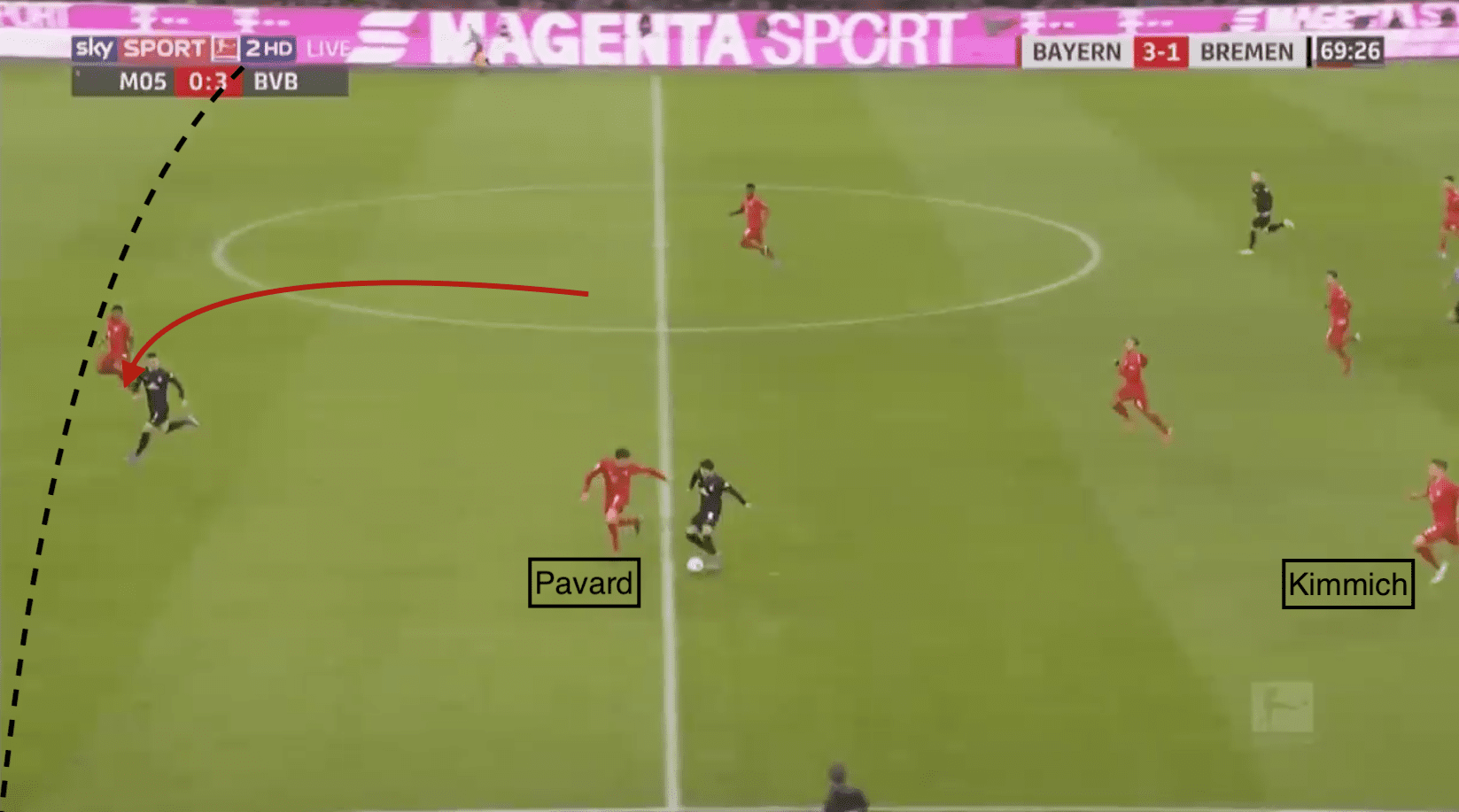
There is a huge amount of space behind Alaba, with Rashica, who is notoriously quick, ready to exploit this and challenge Alaba 1vs1. We already mentioned the fact that the Austrian is quite good in 1vs1 challenges and this is proven once again in this situation. Alaba does not win the ball back straight away but he is able to slow down Rashica and get the help of Pavard to reduce the threat of the attack and assemble an adequate defensive shape. Werder’s attack fizzles out after a promising opening, thanks to some more great defensive covering from Alaba.
Final Remarks
The analysis of Alaba’s superb campaign showcases why he is so important to the club and thus, it’s no surprise that Bayern Munich are desperate for him to sign an extension as he only has a year left on his current deal. His contributions to the club have contributed to Bayern’s rise to the top of the table after their mediocre start, and they now sit four points ahead of rivals Borussia Dortmund.
His performances this season have been so outstanding that rumours are circulating that Hansi Flick will continue to play the 27-year-old at centre-back next season if he stays at the club. With the emergence of Alphonso Davies at left-back too, Alaba can also play a key role to his development as a mentor so signing the Austrian to a new deal is one of Bayern’s top priorities heading into the summer.




Comments